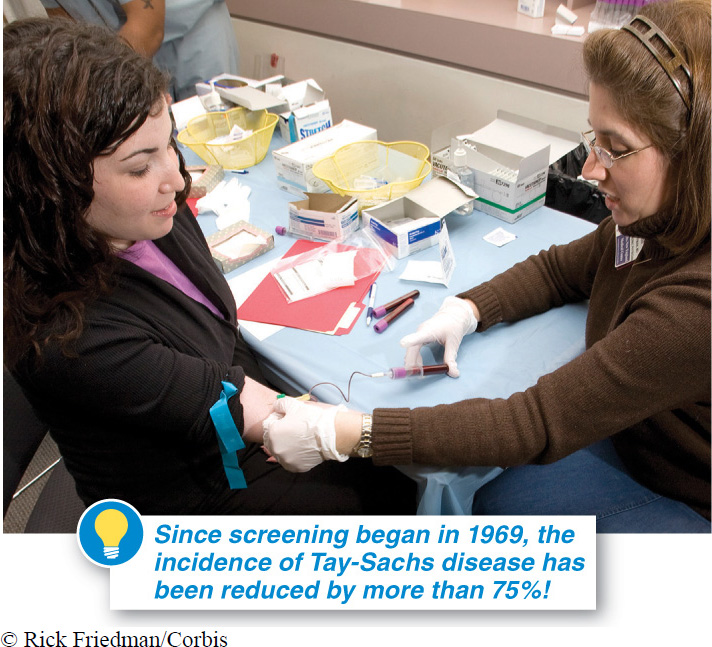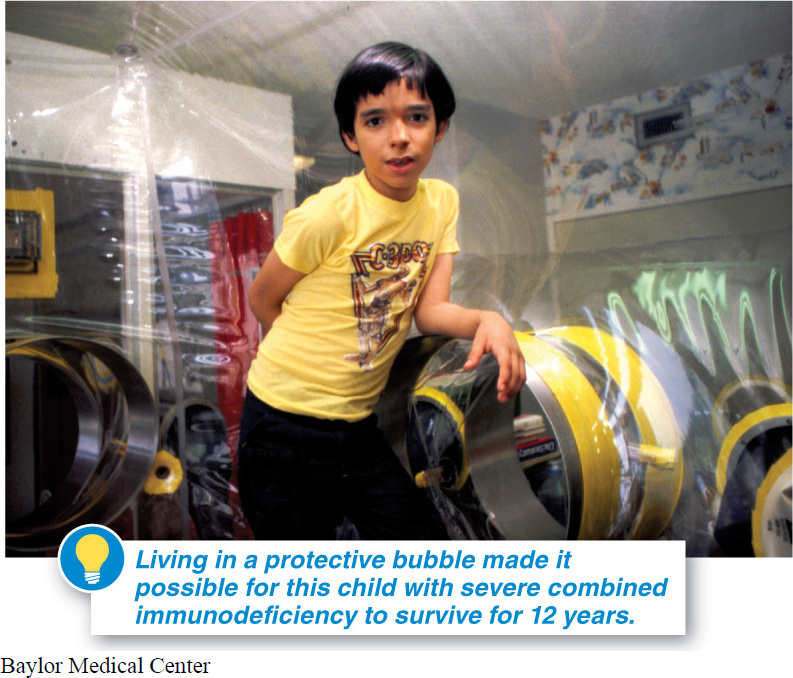Would you want to know? Once, this was just a hypothetical question: if you carried a gene that meant you were likely to develop a particular disease later in your life, would you want to know about it? Or another question: would you want to know if there’s a good chance that your future children will be born with a genetic disease? Now, for better or for worse, these are becoming real-
Intervening to prevent diseases through biotechnology focuses on answering certain questions posed at three different points in time.
1. Is a given set of parents likely to produce a baby with a genetic disease? Many genetic diseases occur only if an individual inherits two copies of the disease-

2. Will a baby be born with a genetic disease? Once fertilization has occurred, it is possible to test an embryo or developing fetus for numerous genetic problems. Prenatal genetic screening can detect cystic fibrosis, sickle-
To screen the fetus, doctors must examine some of the fetal cells and/or the amniotic fluid (which surrounds the fetus in the uterus and carries many chemicals produced by the developing embryo). Cells and fluid are usually collected by amniocentesis or chorionic villus sampling (CVS), techniques that we explore in detail in Chapter 6.
3. Is an individual likely to develop a genetic disease later in life? DNA technology can also be used to detect disease-
These potential benefits of genetic technology come with significant potential costs. People who have a gene that puts them at increased risk of developing a particular disease, for example, might be discriminated against, even though they are not currently sick and may never suffer from the particular disease. Although a federal Genetic Information Nondiscrimination Act was signed into law in 2008, the law does not cover life insurance, disability insurance, and long-
218
When it comes to curing a disease by using biotechnology, there is good news and bad news. The good news is that, in the 1990s, a handful of humans with a usually fatal genetic disease called severe combined immunodeficiency disease (SCID) were completely cured through the application of biotechnology. The bad news is that it has not been possible to apply these promising techniques to other diseases.
It’s not for a lack of trying. There have been more than 500 other clinical trials for gene therapies designed to treat or cure a variety of diseases by inserting a functional gene into an individual’s cells to replace a defective version of the gene. But no clear successes. Not one.
Let’s examine the case of SCID, which has served as a model for gene therapy. SCID is a condition in which a baby is born with an immune system unable to properly produce a type of white blood cell. This leaves the infant vulnerable to most infections and usually leads to death within the first year of life (FIGURE 5-41). In gene therapy for SCID, researchers removed from an affected baby’s bone marrow some stem cells, cells that have the ability to develop into any type of cell in the body. In bone marrow, they normally produce white blood cells, but in individuals with SCID, a malfunctioning gene disrupts normal white blood cell production.

Next, in a test tube, the bone marrow stem cells were infected with a transgenic virus carrying the functioning gene. In cases where the technique worked, the virus inserted the good gene into the DNA of the stem cells, which were then injected back into the baby’s bone marrow. There, the cells could produce normal white blood cells, permanently curing the disease. Although this strategy worked to cure several cases of SCID, treatment has been suspended indefinitely following the recent deaths of two patients from illness related to their treatment.
Why has gene therapy had such a poor record of success in curing diseases?
Difficulties with gene therapy have been encountered in several different areas, usually related to the organism used to transfer the normal-
- 1. Difficulty getting the working gene into the specific cells where it is needed.
- 2. Difficulty getting the working gene into enough cells and at the right rate to produce a physiological effect.
- 3. Difficulty arising from the transfer organism getting into unintended cells.
- 4. Difficulty regulating gene expression.
Beyond these technical problems, for most diseases the malfunctioning gene has not been identified or the disease is caused by more than one malfunctioning gene. And finally, it is important to keep in mind that gene therapy targets cells in the body other than sperm and eggs. Consequently, while a disease might, in theory, be cured in an individual, he or she can still pass on the disease-
TAKE-HOME MESSAGE 5.16
Biotechnology tools have been developed to reduce suffering and the incidence of diseases, but come with significant potential costs. Gene therapy has had a poor record of success in curing human diseases, primarily because of technical difficulties in transferring normal-
Has gene therapy been successful at curing human diseases? Why or why not?
Gene therapy has had little success curing diseases. Success has been hindered by several technical difficulties, including: (1) problems getting working genes into the specific cells where they are needed, (2) problems getting working genes into enough cells and at the right rate to produce a physiological effect, (3) problems with the transfer organism entering unintended cells, and (4) problems with regulating gene expression. Furthermore, more than one faulty gene may cause a disease, or the gene(s) causing a disease may be unidentified.
219